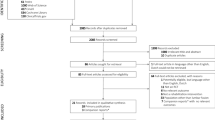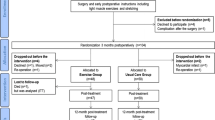Abstract
Purpose
To compare the 9-year outcome in patients with chronic low back pain treated by instrumented lumbar fusion versus cognitive intervention and exercises.
Methods
The main outcome measure was the Oswestry Disability Index (ODI). Secondary outcome measures included pain, fear-avoidance beliefs, trunk muscle strength, medication, and return to work.
Results
One-third of the patients randomized to cognitive intervention and exercises had crossed over and been operated and one-third of the patients allocated to lumbar fusion had been re-operated. The intention-to-treat analysis detected no differences between the two groups. The mean adjusted treatment effect for ODI was 1.9 (95 % CI −7.8 to 11.6). Analysed according to the treatment received, more operated patients used pain medication and were out of work.
Conclusions
The outcome at 9 years was not different between instrumented lumbar fusion and cognitive intervention and exercises.


Similar content being viewed by others
References
Cowan JA Jr, Dimick JB, Wainess R et al (2006) Changes in the utilization of spinal fusion in the United States. Neurosurgery 59:15–20
Fritzell P, Hagg O, Wessberg P et al (2001) 2001 Volvo Award Winner in Clinical Studies: Lumbar fusion versus nonsurgical treatment for chronic low back pain: a multicenter randomized controlled trial from the Swedish Lumbar Spine Study Group. Spine 26:2521–2532
Brox JI, Sorensen R, Friis A et al (2003) Randomized clinical trial of lumbar instrumented fusion and cognitive intervention and exercises in patients with chronic low back pain and disc degeneration. Spine 28:1913–1921
Fairbank J, Frost H, Wilson-MacDonald J et al (2005) Randomised controlled trial to compare surgical stabilisation of the lumbar spine with an intensive rehabilitation programme for patients with chronic low back pain: the MRC Spine Stabilisation Trial. BMJ 330:1233–1239
Brox JI, Reikeras O, Nygaard O et al (2006) Lumbar instrumented fusion compared with cognitive intervention and exercises in patients with chronic back pain after previous surgery for disc herniation: a prospective randomized controlled study. Pain 122:145–155
Brox JI, Nygaard OP, Holm I et al (2010) Four-year follow-up of surgical versus non-surgical therapy for chronic low back pain. Ann Rheum Dis 69:1643–1648
Nguyen TH, Randolph DC, Talmage J et al (2011) Long-term outcomes of lumbar fusion among workers’ compensation subjects: a historical cohort study. Spine 36:320–331
Fairbank JC, Couper J, Davies JB et al (1980) The Oswestry Low Back Pain Disability Questionnaire. Physiotherapy 66:271–273
Grotle M, Brox JI, Vollestad NK (2003) Cross-cultural adaptation of the Norwegian versions of the Roland–Morris Disability Questionnaire and the Oswestry Disability Index. J Rehabil Med 35:241–247
Holm I, Friis A, Storheim K et al (2003) Measuring self-reported functional status and pain in patients with chronic low back pain by postal questionnaires: a reliability study. Spine 28:828–833
Hagg O, Fritzell P, Romberg K et al (2001) The General Function Score: a useful tool for measurement of physical disability. Validity and reliability. Eur Spine J 10:203–210
Grotle M, Vollestad NK, Veierod MB et al (2004) Fear-avoidance beliefs and distress in relation to disability in acute and chronic low back pain. Pain 112:343–352
Grotle M, Brox JI, Vollestad NK (2004) Concurrent comparison of responsiveness in pain and functional status measurements used for patients with low back pain. Spine 29:E492–E501
Waddell G, Newton M, Henderson I et al (1993) A Fear-Avoidance Beliefs Questionnaire (FABQ) and the role of fear-avoidance beliefs in chronic low back pain and disability. Pain 52:157–168
Andrews FM, Robinson JP, Shaver PR et al. (1991) Measures of subjective well-being. Measures of personality and social psychological attitudes. Academic Press, San Diego
Hyytiainen K, Salminen JJ, Suvitie T et al (1991) Reproducibility of nine tests to measure spinal mobility and trunk muscle strength. Scand J Rehabil Med 23:3–10
Keller A, Hellesnes J, Brox JI (2001) Reliability of the isokinetic trunk extensor test, Biering–Sorensen test, and Astrand bicycle test: assessment of intraclass correlation coefficient and critical difference in patients with chronic low back pain and healthy individuals. Spine 26:771–777
Karatas GK, Gogus F, Meray J (2002) Reliability of isokinetic trunk muscle strength measurement. Am J Phys Med Rehabil 81:79–85
Crisostomo RA, Schmidt JE, Hooten WM et al (2008) Withdrawal of analgesic medication for chronic low-back pain patients: improvement in outcomes of multidisciplinary rehabilitation regardless of surgical history. Am J Phys Med Rehabil 87:527–536
Diwan AD, Parvartaneni H, Cammisa F (2003) Failed degenerative lumbar spine surgery. Orthop Clin North Am 34:309–324
Hagg O, Fritzell P (2003) Randomized clinical trial of lumbar instrumented fusion and cognitive intervention and exercises in patients with chronic low back pain and disc degeneration. Spine 28:1913–1921
Brox JI, Sorensen R, Friis A et al (2004) Re: Randomized clinical trial of lumbar instrumented fusion and cognitive intervention and exercises in patients with chronic low back pain and disc degeneration. Spine 29:1160–1161
Acknowledgments
The long-term follow-up study was funded by the Research Council of Norway.
Conflict of interest
None.
Author information
Authors and Affiliations
Corresponding author
Rights and permissions
About this article
Cite this article
Froholdt, A., Reikeraas, O., Holm, I. et al. No difference in 9-year outcome in CLBP patients randomized to lumbar fusion versus cognitive intervention and exercises. Eur Spine J 21, 2531–2538 (2012). https://doi.org/10.1007/s00586-012-2382-0
Received:
Revised:
Accepted:
Published:
Issue Date:
DOI: https://doi.org/10.1007/s00586-012-2382-0




